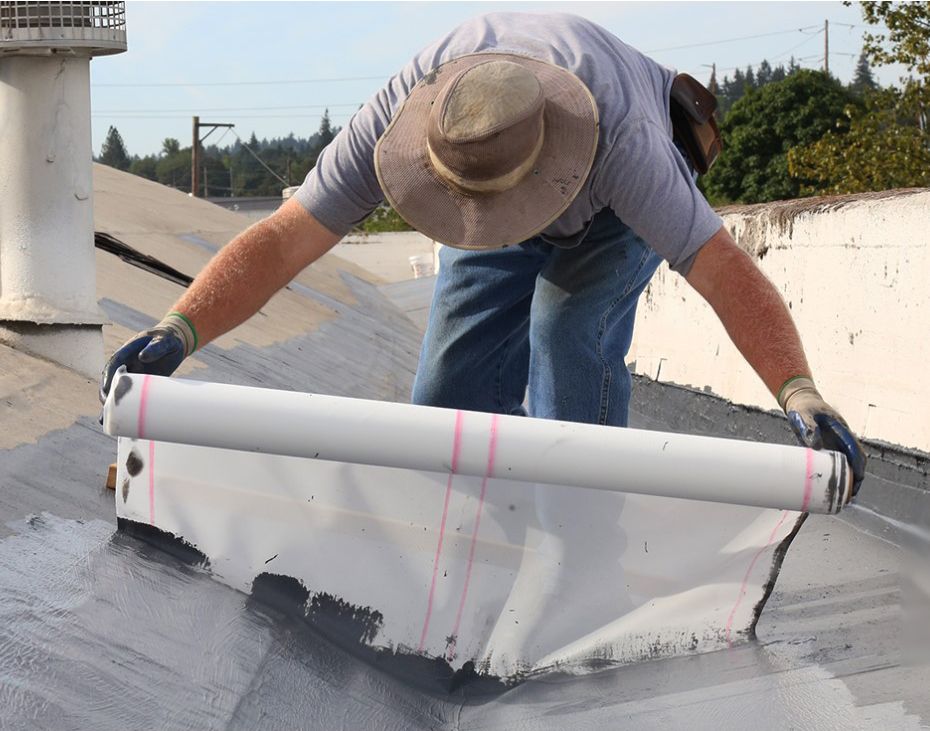🔑 Key Takeaway:
When it comes to reinforcing roofing and waterproofing systems, the three most widely used membranes are cotton fabric, polyester fabric, and fiberglass mat. Each has its own strengths, weaknesses, and ideal use cases. Understanding the difference between these materials helps contractors choose the best membrane for durability, flexibility, cost, and system compatibility.
What Are Reinforcement Membranes in Roofing?
Reinforcement membranes are fabric-like materials that are embedded in roofing coatings or layered within membranes to improve strength, flexibility, crack resistance, and waterproofing integrity. They’re essential in:
-
Cold-applied coatings
-
Torch-down bitumen systems
-
Liquid roofing
-
Roof repairs and flashing details
The three most common types of reinforcement membranes are made from cotton, polyester, or fiberglass. While they serve a similar function — strengthening the roof system — their material makeup changes how they perform in the field.
Cotton Fabric Membrane: The Traditional Workhorse
Cotton Fabric Membrane - Roofing Accessories - Shop Now
Cotton fabric is a natural, biodegradable woven cloth made from cotton fibers. It’s one of the oldest reinforcement materials in roofing, used heavily in built-up roofing (BUR) systems, especially before the rise of synthetics.
What sets cotton apart is its absorbency. It soaks up roof coatings like asphalt emulsion, cold tar, or roof cement, bonding extremely well and creating a thick, waterproof layer when saturated. Cotton’s flexibility makes it easy to conform to curves, flashing, and seams, making it a great choice for patches and repairs.
However, cotton membranes are not fire-resistant and should not be used in torch-applied systems. They're also prone to degrading over long periods if exposed to moisture or UV light without proper coating protection. Still, in cold-applied systems or for eco-conscious or restoration projects, cotton remains a viable, cost-effective option.
Polyester Membrane: The Flexible Powerhouse
Polyester membranes are made from non-woven synthetic fibers that are bonded together using heat and pressure. These fabrics are specifically engineered for maximum flexibility, high tensile strength, and elongation — meaning they stretch and move with the building without tearing.
This makes polyester ideal for roofing systems subject to thermal expansion, such as large commercial flat roofs, metal decks, or surfaces exposed to extreme climate fluctuations. It’s widely used in:
-
Acrylic and silicone roof coatings
-
Polyurethane waterproofing systems
-
Cold-process roof membranes
-
Multi-ply reinforcement over seams and detail areas
Polyester is often embedded between coating layers to help the system withstand movement, bridge cracks, and resist tearing. It performs well under UV exposure, resists moisture, and is compatible with virtually all modern coating types.
While not as naturally fire-resistant as fiberglass, polyester offers excellent all-around performance and is often considered the most versatile membrane for today’s liquid-applied roofing applications.
Fiberglass Membrane: The Stable Reinforcer
Fiberglass membrane, or glass fiber mat, is made from ultra-fine strands of glass woven or formed into mesh or non-woven sheets. It is completely inorganic, which makes it naturally fireproof, rot-resistant, and dimensionally stable.
Unlike cotton or polyester, fiberglass does not stretch. This lack of elongation makes it ideal for rigid, stable roofing systems that are not subject to expansion or movement. It’s widely used in:
-
Torch-down bitumen membranes (APP/SBS)
-
Roofs with cementitious coatings
-
Acrylic or elastomeric systems where shape retention is crucial
-
EIFS systems and wall coatings
Fiberglass membranes are especially common in modified bitumen roofing rolls, where they form the internal structure that holds the sheet together during and after torching. They are also used in roof restoration coatings to prevent cracking and splitting over time.
While fiberglass lacks the flexibility of polyester, it offers better fire resistance, UV stability, and long-term structural support in non-moving assemblies.
Which Membrane Should You Use?
The right choice depends on your roof type, coating system, environmental exposure, and installation method.
Use cotton membrane when:
-
You’re applying cold asphalt or emulsion by hand
-
You're doing a roof patch or flashing repair
-
You want a natural, biodegradable reinforcement
-
You're restoring an older built-up roofing system
-
You’re working in an eco-sensitive or torch-free area
Use polyester membrane when:
-
The roofing system expands and contracts
-
You’re embedding fabric into acrylic, silicone, or polyurethane coatings
-
You need high flexibility and tensile strength
-
You’re working on metal roofs, flat commercial systems, or parapet seams
-
You want a highly durable, multi-purpose solution that works with many coating types
Use fiberglass membrane when:
-
The system will not experience much structural movement
-
Fire resistance is a priority (e.g., torch-down systems)
-
You’re using hot-applied or cementitious coatings
-
You’re reinforcing a stable roof that needs longevity and dimensional accuracy
-
You want a low-cost option for large surface coverage in rigid applications
Final Thoughts: Choosing the Right Roofing Membrane
Every roofing project is different — and so is the reinforcement it needs. Cotton, polyester, and fiberglass membranes all serve essential roles in the roofing industry, but selecting the right one requires understanding how they interact with the roof system and environment.
-
Cotton is simple, absorbent, and natural — great for traditional repairs and cold-application use.
-
Polyester is strong, flexible, and modern — the best all-around choice for active or moving roofs.
-
Fiberglass is rigid, fire-safe, and durable — a dependable option for bitumen-based or high-heat systems.
When you pick the membrane that aligns with your coating chemistry, installation method, and building movement, you’ll drastically improve the performance and lifespan of the entire roof system.
More in depth content on these membranes can be found here:

